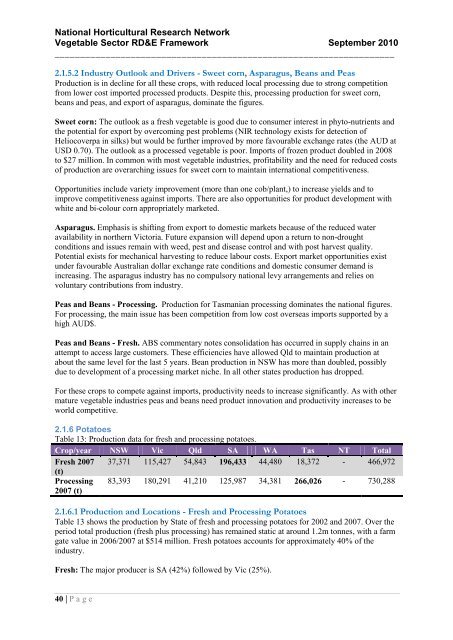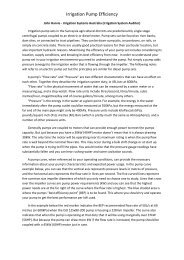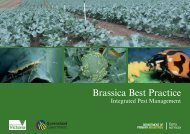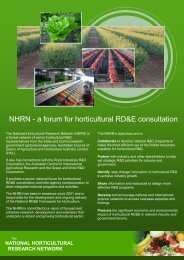National Horticultural Research Network - Horticulture Industry ...
National Horticultural Research Network - Horticulture Industry ...
National Horticultural Research Network - Horticulture Industry ...
Create successful ePaper yourself
Turn your PDF publications into a flip-book with our unique Google optimized e-Paper software.
<strong>National</strong> <strong>Horticultural</strong> <strong>Research</strong> <strong>Network</strong><br />
Vegetable Sector RD&E Framework September 2010<br />
___________________________________________________________________<br />
2.1.5.2 <strong>Industry</strong> Outlook and Drivers - Sweet corn, Asparagus, Beans and Peas<br />
Production is in decline for all these crops, with reduced local processing due to strong competition<br />
from lower cost imported processed products. Despite this, processing production for sweet corn,<br />
beans and peas, and export of asparagus, dominate the figures.<br />
Sweet corn: The outlook as a fresh vegetable is good due to consumer interest in phyto-nutrients and<br />
the potential for export by overcoming pest problems (NIR technology exists for detection of<br />
Heliocoverpa in silks) but would be further improved by more favourable exchange rates (the AUD at<br />
USD 0.70). The outlook as a processed vegetable is poor. Imports of frozen product doubled in 2008<br />
to $27 million. In common with most vegetable industries, profitability and the need for reduced costs<br />
of production are overarching issues for sweet corn to maintain international competitiveness.<br />
Opportunities include variety improvement (more than one cob/plant,) to increase yields and to<br />
improve competitiveness against imports. There are also opportunities for product development with<br />
white and bi-colour corn appropriately marketed.<br />
Asparagus. Emphasis is shifting from export to domestic markets because of the reduced water<br />
availability in northern Victoria. Future expansion will depend upon a return to non-drought<br />
conditions and issues remain with weed, pest and disease control and with post harvest quality.<br />
Potential exists for mechanical harvesting to reduce labour costs. Export market opportunities exist<br />
under favourable Australian dollar exchange rate conditions and domestic consumer demand is<br />
increasing. The asparagus industry has no compulsory national levy arrangements and relies on<br />
voluntary contributions from industry.<br />
Peas and Beans - Processing. Production for Tasmanian processing dominates the national figures.<br />
For processing, the main issue has been competition from low cost overseas imports supported by a<br />
high AUD$.<br />
Peas and Beans - Fresh. ABS commentary notes consolidation has occurred in supply chains in an<br />
attempt to access large customers. These efficiencies have allowed Qld to maintain production at<br />
about the same level for the last 5 years. Bean production in NSW has more than doubled, possibly<br />
due to development of a processing market niche. In all other states production has dropped.<br />
For these crops to compete against imports, productivity needs to increase significantly. As with other<br />
mature vegetable industries peas and beans need product innovation and productivity increases to be<br />
world competitive.<br />
2.1.6 Potatoes<br />
Table 13: Production data for fresh and processing potatoes.<br />
Crop/year NSW Vic Qld SA WA Tas NT Total<br />
Fresh 2007 37,371 115,427 54,843 196,433 44,480 18,372 - 466,972<br />
(t)<br />
Processing<br />
2007 (t)<br />
83,393 180,291 41,210 125,987 34,381 266,026 - 730,288<br />
2.1.6.1 Production and Locations - Fresh and Processing Potatoes<br />
Table 13 shows the production by State of fresh and processing potatoes for 2002 and 2007. Over the<br />
period total production (fresh plus processing) has remained static at around 1.2m tonnes, with a farm<br />
gate value in 2006/2007 at $514 million. Fresh potatoes accounts for approximately 40% of the<br />
industry.<br />
Fresh: The major producer is SA (42%) followed by Vic (25%).<br />
40 | P a g e






